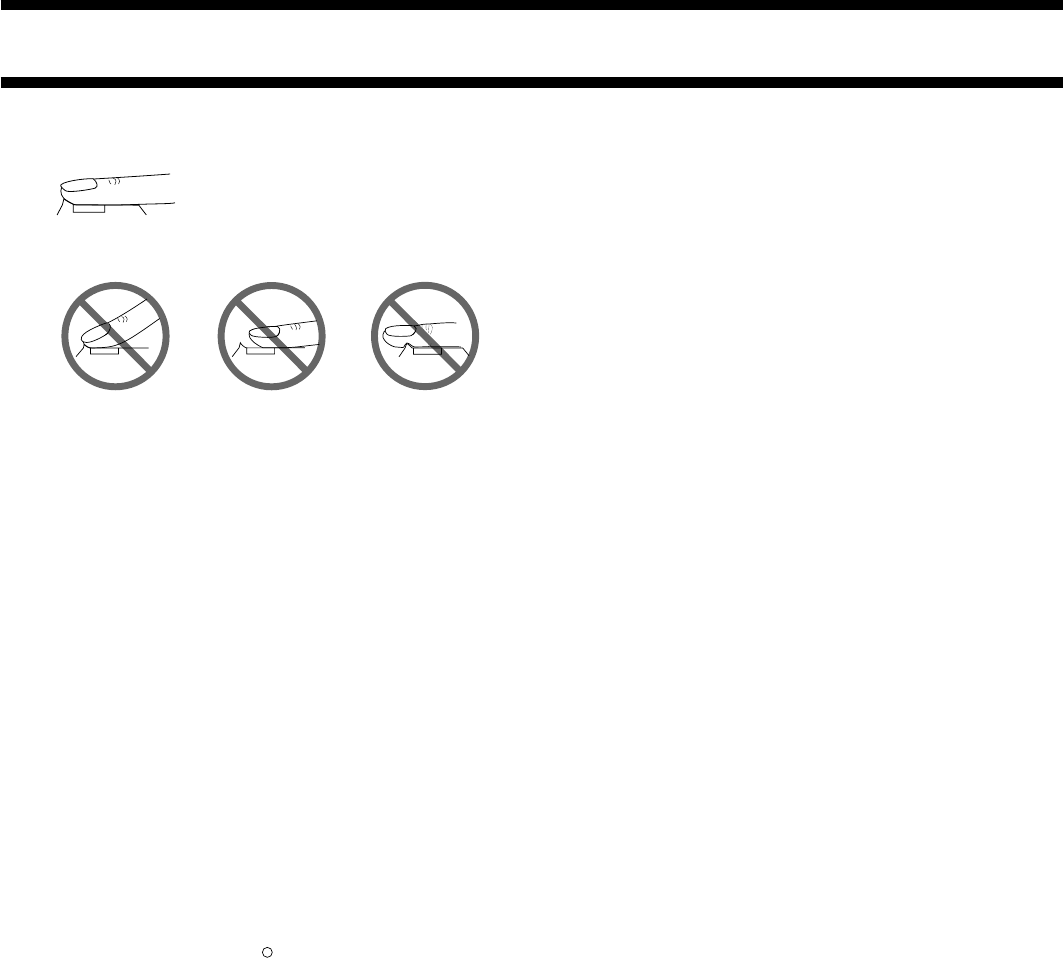
2196-6
Place your finger on the sensor so that the
pad of the finger (not the fingertip) is
covering the photosensor. If your fingernail
turns white, it means you are pressing too
hard. Your fingertip should be resting lightly
on the sensor so it is just brushing against
the photosensor lens.
Correct
Incorrect
Finger too upright.
Finger too far back on
the photosensor.
Finger too far
forward on the
photosensor.
Tips on Taking Measurements
Use the following techniques to ensure correct blood pressure
measurements every time.
• When you are out of breath, your finger may move and cause
problems with taking measurements. Wait for about five minutes
before taking measurements.
• Once you start the measurement procedure, place your finger on the
sensors as soon as possible.
• During measurements, keep still and do not talk.
• You should not be wearing a ring or any other object that restricts
normal blood flow on the finger you place on the sensor.
• Avoid bright light when taking measurements.
• Do not take measurements near a TV or motor.
Important!
The following factors may make it difficult or even impossible to achieve
good blood pressure readings with the Watch.
• Severe arrhythmia
Pulse waves are unstable, so they cannot be detected properly by the
photosensor.
• Arteriosclerosis or other circulatory problems
Circulation at the fingertips is bad, so the photosensor cannot detect
pulse waves.
• Thick fingertip skin
Thick skin impedes the passage of light through the fingertip. This
makes it hard for the photosensor to take readings.
• Hairy arms
Electrical potential cannot be accurately measured unless the back
cover’s electro-potential sensor (
+
) is in close contact with the skin.
Try taking the measurement in a place where close skin contact can
be maintained.
You can also try moving the Watch to it is on the inside of your left
wrist.
REFERENCE
This section contains more detailed and technical information about
Watch operation. It also contains important precautions and notes about
the various features and functions of this Watch.
Auto Return Features
• If you leave the Watch in the Measurement Mode and Recall Mode for
five to six minutes without performing any operation, the Watch
automatically returns to the Timekeeping Mode.
• If you leave a screen with flashing digits on the display for two or three
minutes without performing any operation, the Watch automatically
saves anything you have input up to that point and exits the setting
screen.
Data and Setting Scrolling
The B button is used to scroll through setting screen data on the
display. In most cases, holding down this button during a scroll operation
scrolls through the data at high speed.
Timekeeping
• The year can be set in the range of 2000 to 2039.
• The Watch’s built-in full automatic calendar automatically makes
allowances for different month lengths and leap years. Once you set
the date, there should be no reason to change it except after you have
the Watch’s battery replaced.
12-hour/24-hour Timekeeping Formats
The 12-hour/24-hour timekeeping format you select in the Timekeeping
Mode is also applied in all modes.
• With the 12-hour format, the P (PM) indicator appears to the left of the
hour digits for times in the range of noon to 11:59 p.m. and no
indicator appears to the left of the hour digits for times in the range of
midnight to 11:59 a.m.
• With the 24-hour format, times are displayed in the range of 0:00 to
23:59, with 24 indicator.
Backlight Precautions
In any mode (except for the Measurement Mode), press B to illuminate
the display for about one second.
• The electro-luminescent panel that provides illumination loses power
after very long use.
• The illumination provided by the backlight may be hard to see when
viewed under direct sunlight.
• The Watch may emit an audible sound whenever the display is
illuminated. This is due to vibration of the EL panel used for
illumination, and does not indicate malfunction.
• The backlight automatically turns off whenever an alarm sounds.
• Frequent use of the backlight shortens the battery life.









